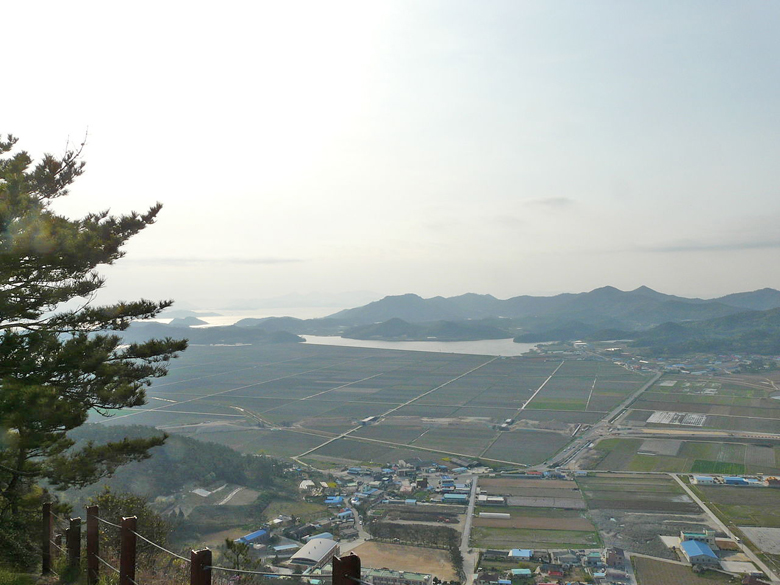Jindo Is the third largest island in the Republic of Korea after Jeju and Kojedo, together with a group of smaller islands it forms Jindo County.
Jindo is mainly porphyry, and the eastern and eastern part of the island is composed of mountain areas such as Cheomchalsan (482 m) and Yeogwisan (458.4 m), but the elevation in the northwestern part is low, and the flatland occupies 32% of the total area. Most of the plains are hilly, and the basins of Bathcheon Stream and Chimggye Stream are fertile, making them suitable for agricultural land. It is the center of offshore fishing, and is famous for producing sea bream, blackfish, and seaweed, as well as Jogi. The folk song Jindo Arirang and Jindo Dog, protected by Natural Monument No. 53, are widely known.
This island is famous for the fact that every year on the last day of February and in the middle of June according to the lunar calendar, a sea road is opened here. In honor of the story about Moses from the Old Testament, it was named “The Miracle of Moses.” This road, which is about 30-40 m wide and 2.8 km long, opens completely for 1 hour and then closes back.
when the sea road opens, people hold the Yeongdeung festival here. During the festival, the area hosts traditional Jindo Island performances, which attracts a large number of tourists.
Access : Coordinates: 34.483056, 126.261944 / Jindo Located in Jeollanam-do province, at the southwestern tip of the Korean Peninsula. It is separated from the mainland by the Myeongniang Strait, this strait is now spanned by South Korea’s longest cable-stayed bridge spanning about 484 meters.
Highlights :
- Natural event : Every year, mostly two or three days between March and June, a narrow strip of sea surface (approx. 2.9 km long and up to 40 m wide) falls dry and for about an hour between the main island Jindo and the small island Modo due to the tidal activity can be done on foot.
“Moisee’s miracle”
Jindo Miracle Sea Road Festival : Twice a year, an unusual natural phenomenon occurs near the island, reminiscent of the biblical story, in which the waters of the Red Sea parted for Moses: between the regions of Kogun-myeon Hvedon-ni and Uisin-myeon Modo-ri, sea water “parted” and for one hour a road wide about 40 meters and a length of 2.8 km, connecting the islands of Chindo and Modo. - Chindodegyo Bridge : The Chindodegyo Bridge across the Myeongniang Strait, which connects the island to the mainland, is a double bridge consisting of two twin bridges of similar design.
- Korean jindo : Jindo Island is home to the Korean Jindo or Chindokke, a breed of hunting dog listed as a National Treasure of Korea at No. 53.
- Ullimsanban Workshop : On the island, in the western region of the Chomchkhalsan mountains, not far from the Buddhist temple of the “two valleys” of Ssages, there is an art workshop Ullimsanban, in which in the last years of his life lived and worked a representative of the southern school of Chinese landscape painting Namjonghwa – Korean artist Ho Ryong (1808-1893).
- The Sebannakcho viewpoint : On the west coast of Chindo Island, there is the Sebannakcho viewpoint. It offers a view of the Tadohe maritime archipelago, especially transforming at sunset, for which the site got its name Sebannakcho, “nakcho” in Korean means “rays of the setting sun”
- The Stone Seated Buddha in Yongjangsa temple / The five-story stone pagoda, On the grounds of the Geumsong Elementary School in Gunnae-myeo./ The Victory monument of Admiral Lee, in Byeokpa-ri, Gogun-myeon / Namdo Stone Fortress.
- Ssangesa Temple in Jindo : The Ssanggyesa Temple was built during the Silla era by the Buddhist monk Tosonguksa, The temple is located between two valleys.
- Ssitgim-gut : Ssitgim-gut is a shamanic ritual performed by the people of Jindo. This ritual is performed to connect the human realm with the dead. Ssitgim-gut is believed to be able to take the soul of a person who has died to heaven and cleanse all the desires that remain in the world.
Go next : The neaby island of Modo / The cities of Mokpo and Gwangju / The iconic world famous green tea plantations of Boseong.

